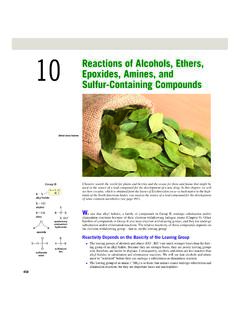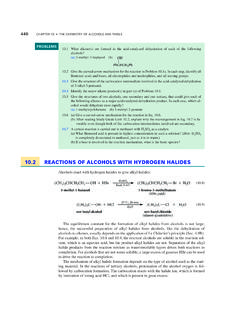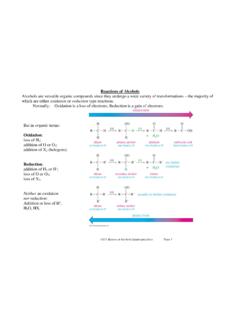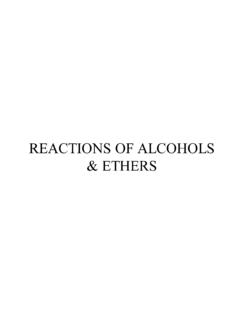Search results with tag "Reactions of alcohols"
10 Reactions of Alcohols, Ethers, Epoxides, Amines, and
www.pearsonhighered.com10.1 Nucleophilic Substitution Reactions of Alcohols: Forming Alkyl Halides 461 the S N2 Reaction of primary alcohols Primary alcohols cannot undergo S N1 reactions because primary carbocations are too unstable to be formed, even when the reaction is heated (Section 9.3).
Chapter 3 Alcohols, Phenols, and Ethers
www.angelo.eduChapter 3 Alcohols, Phenols, and Ethers 13 25 Reactions of Alcohols 26 Dehydration of Alcohols to Produce Alkenes • Heating alcohols in concentrated sulfuric acid (H2SO4) at 180°C removes the OH group and a H from an adjacent carbon to produce an alkene, with water as a by-product. Since water is “removed”
10.2 REACTIONS OF ALCOHOLS WITH HYDROGEN HALIDES
www.saplinglearning.com10.2 REACTIONS OF ALCOHOLS WITH HYDROGEN HALIDES 441 (10.10a) Once the alcohol is protonated, the reaction is an S N1reaction with H 2O as the leaving group. When a primary alcohol is the starting material, the reaction occurs as a concerted displace-
Chapter 17: Alcohols and Phenols
as.vanderbilt.edu17.7 Some reactions of alcohols A. Reactions involving the C-O bond Dehydration to alkenes: E1 mechanism (reactivity: 3° > 2° >> 1°) requires strong acid catalyst (H 2SO 4) water is a much better leaving group than HO-usually follows Zaitzev’s rule OH H 3CCCH 2CH 3 CH 3 H 2SO 4 H 2O, 3THF C H 3C H 3C C CH H H2C C H 23-H 2O 95 Dehydration ...
Reactions of Alcohols - Rutgers University
crab.rutgers.eduThe first step is the exothermic protonation of the hydroxyl, followed by the slow, endothermic, rate determining ionization to generate the cation. The fast deprotonation is exothermic and produces the alkene. Since the RDS is the formation of the carbocation, the ease of formation dictates the reaction rates of 3° > 2° > 1°.
REACTIONS OF ALCOHOLS
www.ntci.on.ca6. Acid-Base Reactions • Like water, alcohols can act as an acid or base, depending on what it is reacting with. • When they react as an acid, the alkyl oxide ion (R-CH2O-) is formed. ethanol + sodium ethoxide ion + sodium ion + hydrogen 2 CH3CH2OH + 2 Na 2 CH3CH2O-+ 2 Na+ + H2





